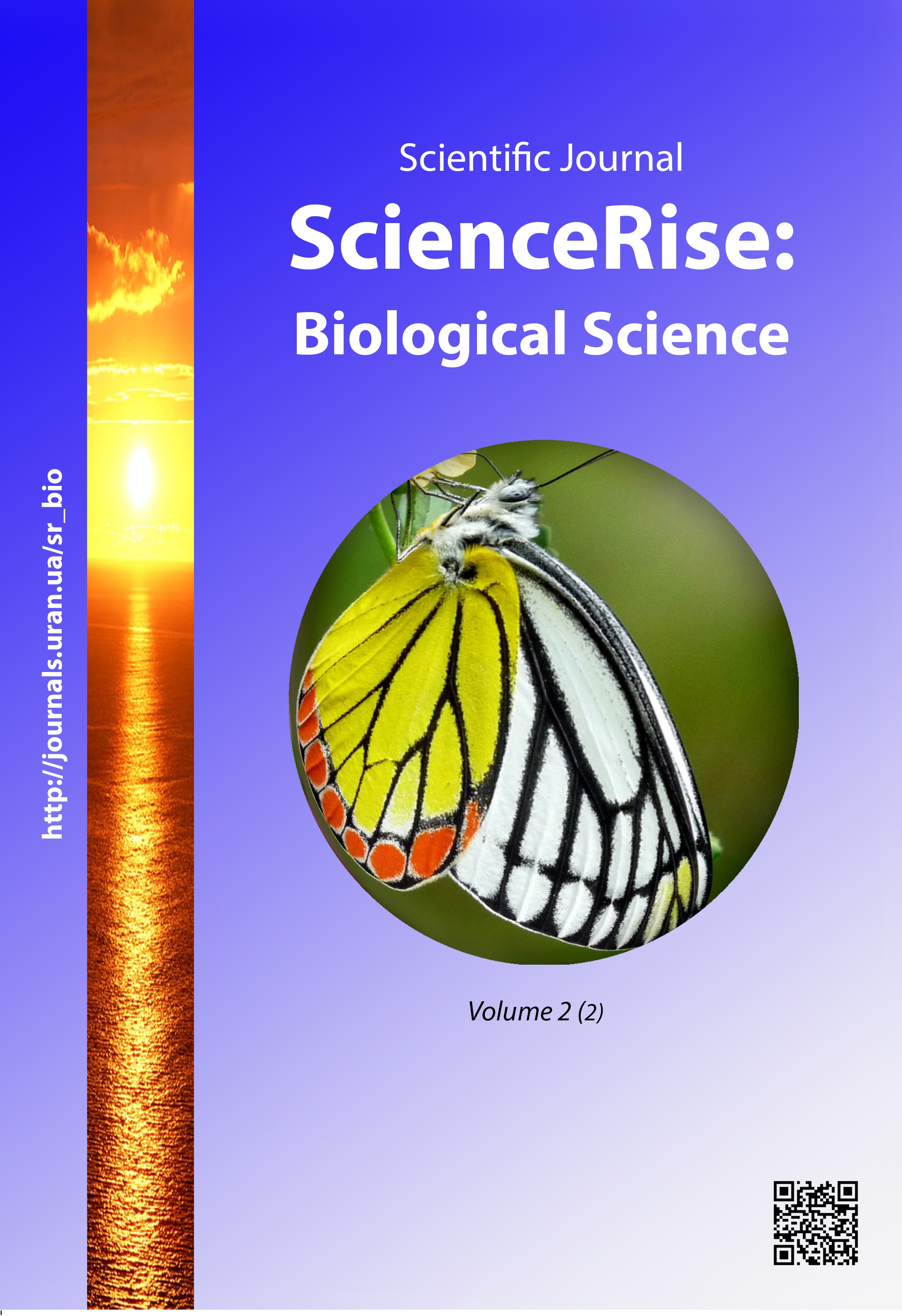Change in biochemical profile of rats under carbon tetrachloride-induced liver injury
DOI:
https://doi.org/10.15587/2519-8025.2016.81836Keywords:
blood biochemical parameters, cytokines, antioxidant enzymes, toxic liver injuryAbstract
The carbon tetrachloride-induced rat model of liver injury was described. Changes in serum biochemical parameters indicate a progressive process of the hepatocyte destruction and intrahepatic cholestasis, which most likely is the result of oxidative stress activation in response to toxicants. Our results also demonstrated an imbalance of pro- and anti-inflammatory cytokines under conditions of tetrachloroethane intoxication
References
- Häussinger, D. (1996). Physiological Functions of the Liver. Comprehensive Human Physiology, 1369–1391. doi: 10.1007/978-3-642-60946-6_68
- Gumucio, J. J., Chianale, J.; Arias, I. M., Jacoby, W. B., Popper, H., Schachter, D., Shafritz, D. A. (Eds.) (1988). Liver cell heterogeneity and liver function. The Liver: Biology and Pathobiology. New York: Raven Press, 931–947.
- Bhakuni, G. S., Bedi, O., Bariwal, J., Deshmukh, R., Kumar, P. (2015). Animal models of hepatotoxicity. Inflammation Research, 65 (1), 13–24. doi: 10.1007/s00011-015-0883-0
- Liu, Y., Meyer, C., Xu, C., Weng, H., Hellerbrand, C., ten Dijke, P., Dooley, S. (2012). Animal models of chronic liver diseases. AJP: Gastrointestinal and Liver Physiology, 304 (5), G449–G468. doi: 10.1152/ajpgi.00199.2012
- Singh, G., Dhadwal, N., Harikumar, S. L. (2015). Еxperimental models for hepatotoxicity. Asian J. Pharm. Clin. Res., 8 (2), 70–74
- Muriel, P. (2009). Role of free radicals in liver diseases. Hepatology International, 3 (4), 526–536. doi: 10.1007/s12072-009-9158-6
- Weber, L. W. D., Boll, M., Stampfl, A. (2003). Hepatotoxicity and Mechanism of Action of Haloalkanes: Carbon Tetrachloride as a Toxicological Model. Critical Reviews in Toxicology, 33 (2), 105–136. doi: 10.1080/713611034
- Comporti, M. (1989). Three models of free radical-induced cell injury. Chemico-Biological Interactions, 72 (1-2), 1–56. doi: 10.1016/0009-2797(89)90016-1
- Manibusan, M. K., Odin, M., Eastmond, D. A. (2007). Postulated Carbon Tetrachloride Mode of Action: A Review. Journal of Environmental Science and Health, Part C, 25 (3), 185–209. doi: 10.1080/10590500701569398
- Smol’yakova, V. I., Plotnikov, M. B., Chernyshova, G. A., Ivanov, I. S., Prosenko, A. E., Kandalintseva, N. V. (2011). Hepatoprotective effect of thiophane in rats with experimental carbon tetrachloride-induced hepatitis. Experimental and Clinical Pharmacology, 74 (8), 37–40.
- Faizullin, A. V. (2013). Histomorphologycal evaluation of the therapeutic action of spissum extract of vitus vinifera leaves, under acute hepatitis, caused by carbon tetrachloride. Ukrai'ns'kyj medychnyj al'manah, 16 (2), 148–150.
- Dongare, P. P., Dhande, S. R., Kadam, V. J. (2013). Standardization of carbon tetrachloride-induced hepatotoxicity in the rat. Am. J. PharmTech Res., 3 (5).
- Drahulian, M., Gulko, T., Kordium, V. A., Deryabina, O. (2014). Modelling of toxic liver damage on line ICR mice. ScienceRise, 4/1 (4), 13–20. doi: 10.15587/2313-8416.2014.29151
- Halenova, T. I., Vareniuk, I. M., Roslova, N. M., Dzerzhynsky, M. E., Savchuk, O. M., Ostapchenko, L. I. et. al. (2016). Hepatoprotective effect of orally applied water-soluble pristine C60 fullerene against CCl4-induced acute liver injury in rats. RSC Adv., 6 (102), 100046–100055. doi: 10.1039/c6ra20291h
- Ragulinа, V. A. (2012). Relationshipbetween theantioxidanteffect of 3-hydroxypyridine and theirinfluenceon endothelium vasodilatingeffect inendothelial dysfunction v.a. ragulinа. Belgorod State University Scientific Bulletin. Medicine. Pharmacy, 4 (123), 212–216.
- Rybalchenko, V. K., Koganov, M. M. (1988). Structure and function of membrane. Кyiv: Vischa Shkola, 312.
- Sirota, T. V. (1999). A new approach to the investigation of adrenaline autooxidation and its application for determination of superoxide dismutase activity. Biomeditsinskaya Khimiya, 45 (3), 263–272.
- Korolyuk, M. A., Ivanova, L. I., Maiorova, I. G., Tokarev, V. E. (1988). A method for measuring catalase activity. Lab Delo, 16–19.
- Bradford, M. M. (1976). A Rapid and Sensitive Method for the Quantitation of Microgram Quantities of Protein Utilizing the Principle of Protein-Dye Binding. Analytical Biochemistry, 72, 248–254.
- Nyblom, H., Bjornsson, E., Simren, M., Aldenborg, F., Almer, S., Olsson, R. (2006). The AST/ALT ratio as an indicator of cirrhosis in patients with PBC. Liver International, 26 (7), 840–845. doi: 10.1111/j.1478-3231.2006.01304.x
Downloads
Published
How to Cite
Issue
Section
License
Copyright (c) 2016 Тетяна Іванівна Галенова, Наталія Григорівна Ракша, Олексій Миколайович Савчук

This work is licensed under a Creative Commons Attribution 4.0 International License.
Our journal abides by the Creative Commons CC BY copyright rights and permissions for open access journals.
Authors, who are published in this journal, agree to the following conditions:
1. The authors reserve the right to authorship of the work and pass the first publication right of this work to the journal under the terms of a Creative Commons CC BY, which allows others to freely distribute the published research with the obligatory reference to the authors of the original work and the first publication of the work in this journal.
2. The authors have the right to conclude separate supplement agreements that relate to non-exclusive work distribution in the form in which it has been published by the journal (for example, to upload the work to the online storage of the journal or publish it as part of a monograph), provided that the reference to the first publication of the work in this journal is included.









